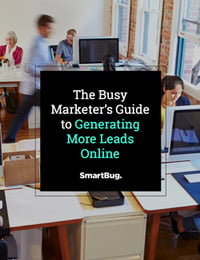
When Website Traffic Is Up and Leads Are Down
October 1, 2019
Seeing the traffic numbers to your website increase is like watching your baby grow up—you're thrilled that it's happening, there's a little guesswork involved, and you want to tell everyone about it.
Though an increase in visitors is fantastic, you want to make sure that you're seeing that same upward motion in your lead conversions. Not happening for you? (Guessing that's the case if you're here.)
Here are three main reasons your leads may be down even though website traffic is up:
- Your content isn't compelling enough.
- Your lead conversion assets aren’t compelling enough.
- Your reputation isn’t compelling enough.
Let's discuss more in-depth below.
Your Content Isn’t Compelling Enough.
If you think of visitors’ personal information—such as their name and email address—as online currency, then your content is what they’re “paying” for with that currency.
If those visitors don’t deem your content worth their “cash,” then they may leave your site without ever converting. So what’s to blame for your content not being up to snuff?
1. Your lead conversion offers may not be relevant to where your visitors are in the funnel or Buyer’s Journey.
If you’re getting a lot of traffic, there’s a good chance you’ve got your awareness content game on lock.
To ensure you’re getting the most bang for your awareness content buck, double-check that you have a piece of consideration-focused content that serves as a reasonable follow-up for each offer. By definition, that consideration content should provide information about specific solutions to the high-level problem or opportunity the awareness piece discussed.
How to fix it: Make sure you have awareness, consideration, and decision stage content for each of your buyer personas.
2. Your content is attracting people who aren’t ready to buy yet.
Many websites lack lead conversion opportunities outside of “contact us” or “request a demo.”
This means that if folks came to your site because a blog posted to social media caught their eye or because they heard the name of your business somewhere before, they have no options for contacting you other than speaking to a sales rep.
And you know what? Chances are, that’s pretty close to the last thing they want right now.
How to fix it: Make sure your site offers visitors lead conversion opportunities in all stages of the marketing funnel. Keep your demo request calls to action, but make sure to include some more educationally focused CTAs as well.
3. Your offers aren’t persona- or Buyer’s Journey-focused enough.
If you were trying to catch a fish, you wouldn’t use a piece of fruit for bait. The same goes for converting visitors into leads: If you want them to “bite,” provide something they’re actually interested in.
How to fix it: Know your personas and their specific pain points, and then create content to address those topics.
4. Sometimes, whether or not your lead conversion content resonates with visitors may be completely out of your control.
Maybe the market crashed, it’s not buying season, or it’s the holidays. Nothing to be done except weather the storm, right? Wrong.
Even if circumstances beyond your control are to blame for your lead numbers going down, you may be able to create new offers that actually take advantage of whatever those circumstances may be.
How to fix it: Create content that addresses the underlying environmental or market conditions that caused lead conversions to decrease. Not your buying season? Create planning documents or tools that allow prospects to monitor their KPIs during the year to get a better idea of what they’ll need when buying season does finally come around. Did the market crash? Put out an offer of free actionable tips to reduce operating costs or expenses.
Your Lead Conversion Assets Aren’t Compelling Enough.
If you have buyer persona- and Buyer’s Journey-focused content that complements your traffic-generating efforts and fits into each stage of the funnel, yet you’re still seeing a decrease in leads, the answer may lie not in the content but in the lead conversion “machinery” promoting those offers.
1. You may not have enough lead conversion opportunities.
The first thing to check is whether or not you have enough conversion opportunities on your site. These include things such as your blog subscription or newsletter sign-up, any forms posted directly on website pages, and, of course, calls to action. Ideally, each page should have one of these lead conversion tools on it.
How to fix it: Perform an audit of all your website pages and double-check to make sure each one contains a lead conversion opportunity. For maximum benefit, place all forms on landing pages behind calls to action.
2. Your lead conversion opportunities may be too hard to find.
If a tree falls in the forest and no one’s there to hear it, does it make a sound?
I’m going to guess the answer to that one is yes, but when it comes to conversion opportunities that are hidden in website footers, behind calls to action that don’t appear clickable, or in links hidden deep in text, the answer is a resounding no: If your conversion opportunities can’t be found, chances are, they’re not going to work.
How to fix it: Make sure your calls to action visually stand out from the page on which they’re located. Craft them in your website accent color or use an eye-catching image or design to help them attract more clicks.
3. Your call to action message may not be compelling enough.
“Check this out when you get a chance” may sound friendly, but it doesn’t make a strong argument for why someone should spend their time and click on your call to action.
Instead of passive, vague language, great calls to action should clearly describe the offer they link to and use actionable verbs to specify how to get that offer. Do yours?
How to fix it: Make sure the text on your calls to action either matches exactly with the offer someone will see on the corresponding landing page or explains it in a way that will resonate with your persona. Also, be sure that your calls to action use, well, actionable language—that is, they include active verbs such as “download” and “get.”
4. Your landing pages may not be well-optimized.
Calls to action aren’t the only piece of conversion process “machinery” whose malfunction might be costing you leads.
Sure, it’s calls to action that generate clicks and landing page visitors, but what happens after those visitors arrive at your landing page itself? If the pages aren’t well-optimized, you could lose those would-be contacts.
How to fix it: To determine if your landing pages are to blame, compare your CTA click rates with page submission rates. If there’s a large discrepancy between the two numbers (with clicks being much higher than submissions), either your forms or your landing page itself may be to blame. Check out what makes a great landing page or read on to see if your forms are the real issue.
5. Your forms may be too long or require too much information.
If your CTA click-throughs are high but submissions are lagging, it may not be your landing page’s fault.
Instead, your forms may be to blame. The number of fields you include (and what information you ask for) should be directly proportional to the value of your offer behind it.
Don’t go “straight for the sell” on an awareness stage form by asking for highly valuable information such as telephone numbers—save such personal information for progressive profiling or lower funnel offers such as free trials or sales consultations.
How to fix it: Forms should be no longer than they have to be to collect the most essential pieces of information you need about each contact. If your form is more than four or five fields in length, carefully scrutinize each additional field: Is it really essential to have this piece of information at this point in the sales process? If the answer is no, remove it. If it’s maybe or probably, consider turning on progressive profiling for that question.
Your Reputation Isn’t Compelling Enough.
You’re sure your content is spot-on and you’ve triple-checked your conversion “machinery.” Traffic numbers look great, but leads are still down. What gives?
If this is the boat you’re in, the problem might not be with your lead conversion content—it might be with you. Now, before you accuse me of sounding too harsh, let me take a moment to explain.
Spammy messages, emails you never signed up for, adware, malware, and even identity theft are unfortunately widely accepted and almost everyday parts of doing business on the internet.
As such, people are trained to be skeptical of websites that ask for any personal information—even something as simple as a request for an email address on a short form. If you’re seeing a lot of traffic that’s not converting into leads, the reason might be that your brand’s reputation or website content hasn’t convinced your visitors that you’re worth their contact information—yet.
How to fix it: If your site doesn’t already use SSL, now is a great time to start. The lock icon that appears next to secured sites’ URLs can go a long way toward instilling confidence that information entered into a website form won’t be intercepted or otherwise misused.
Providing customer testimonials (attributed to real, live human beings), customer stories, case studies, and statistics can also help build visitor confidence in your site and brand. Consider adding a testimonials section to your site or your homepage, and include statistics in your landing page copy. Tell your customers’ stories or create case studies, then make these available on your site and share them with the world via social media.
Having website traffic is great, but it’s all for naught if those visitors don’t convert into leads.
This blog was originally published in February 2016 and has been updated since.

About the author
Jennifer Shore was formerly the Director of Marketing of SmartBug and a Seattle-based writer who has received numerous awards for her work. In her role at SmartBug, she is responsible for the development, execution, and optimization of the high-growth lead funnel, nurturing, and customer acquisition. Read more articles by Jennifer Shore.









